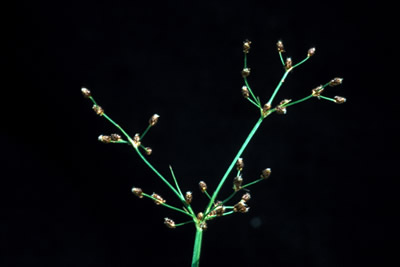Fimbristylis miliacea

Latin name
Fimbristylis miliacea (L.) Vahl
Family
Cyperaceae
Common name
Lesser fimbristylis, grasslike fimbristylis, and hoorahgrass
Synonyms
Fimbristylis littoralis Gaudich., Isolepis miliacea (L.) J. Presl & C. Presl, Scirpus miliaceus L., Trichelostylis miliacea (L.) Nees
Geographical distribution
South and Southeast Asia: Bangladesh, Bhutan, Cambodia, India, Indonesia Lao PDR, Malaysia, Myanmar, Nepal, Pakistan, Philippines, Sri Lanka, Thailand, and Vietnam.
Rest of the world: Ecuador, Madagascar, Nicaragua, Peru, and Suriname.
Morphology
Annual or perennial, without hairs, strongly tillering, with fibrous roots and up to 80−90 cm high.
Stem: slender, erect, densely tufted, compressed, and smooth; strongly angled at the top and flattened at the base; 20−70 cm tall.
Leaf: stiff and thread-like; on flowerless stems: in 2 rows and with flattened sheaths; no prominent midribs; on flowering stems: only linear leaf sheaths; basal leaves have overlapping leaf sheaths; ligule absent.
Inflorescence: 6−10 cm long, compound umbel with 6−50 spikelets; spikelets reddish brown, 2−4 mm long and either round or acute at apex.
Fruit: straw-colored or pale ivory nut, 0.2−0.3 mm long.
Biology and ecology
Propagates by seeds; flowers year-round and produces 10,000 seeds per plant; seeds can germinate immediately after reaching maturity.
In rice fields, seedlings appear soon after rice is sown; flowers in about one month and capable of producing a second generation in the same season. Germinates where flood water is shallow or absent and seedlings may emerge throughout the entire growing period of rice.
Agricultural importance
It is a serious and widespread weed of rice.
An alternate host of diseases Rhizoctonia solani, Thanatephorus cucumeris, and Xanthomonas campestris pv. oryzae, insects Creatonotus gangis Linnaeus, Leptocorisa acuta (Thunberg), and Mythimna separata (Walker), and nematodes Hirschmanniella sp. and Meloidogyne spp.
Management
Cultural control: hand cultivation.
Chemical control: postemergence application of MCPA and 2,4-D reported to be effective in rice.
Selected references
- Galinato MI, Moody K, Piggin. CM. 1999. Upland rice weeds of South and Southeast Asia. Manila (Philippines): International Rice Research Institute. 156 p.
- Holm LG, Plucknett DL, Pancho JV, Herberger JP. 1977. The world's worst weeds: distribution and biology. Honolulu, Hawaii (USA): The University Press of Hawaii. 609 p.
- Kim PV, Hoang VT, Thuy TTT, Hoa LH, Hoai NB. 1981. Host range of Pyricularia oryzae and Thanatephorus cucumeris in the Vietnamese Mekong Delta. Int. Rice Res. Newsl. 6:10.
- Merrill ED. 1976. A flora of Manila. Manila (Philippines): Department of the Interior, Bureau of Science. 491 p.
- Moody K. 1989. Weeds reported in rice in South and Southeast Asia. Manila (Philippines): International Rice Research Institute. 442 p.
- Moody K, Munroe CE, Lubigan, RT, Paller Jr. EC. 1984. Major weeds of the Philippines. College, Laguna (Philippines): Weed Science Society of the Philippines. University of the Philippines at Los Baños. 327 p.







